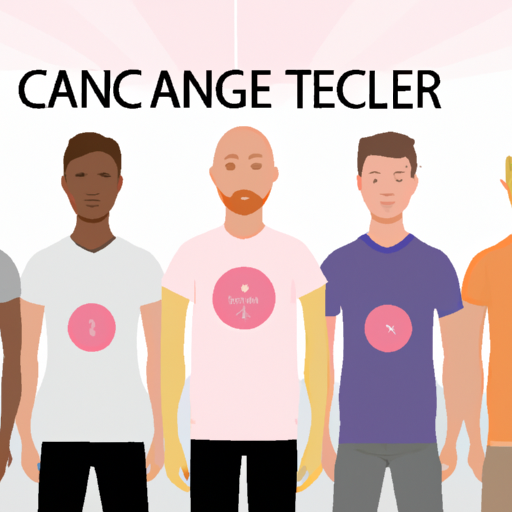Testicular cancer is a relatively rare form of cancer that primarily affects young men between the ages of 15 and 35. Despite its low incidence rate, it is crucial to understand the symptoms, causes, and risk factors associated with this disease in order to detect and treat it at an early stage. This article aims to provide comprehensive information on testicular cancer, covering its symptoms, causes, and risk factors in the first section. The second section will delve into the various diagnostic methods and screening techniques available to detect this cancer at its earliest stages. Lastly, the article will explore the different treatment options, including surgical, radiation, and chemotherapy approaches, that can be used to effectively combat testicular cancer. By delving into these topics, readers will gain a better understanding of this disease and the steps they can take to prevent, detect, and treat it.
1. "Understanding Testicular Cancer: Symptoms, Causes, and Risk Factors"
Testicular cancer is a relatively rare form of cancer that primarily affects young men between the ages of 15 and 35. While it may not receive as much attention as other types of cancer, it is essential to understand the symptoms, causes, and risk factors associated with this disease.
Symptoms of testicular cancer can vary among individuals, but the most common sign is a painless lump or swelling in one or both testicles. Other symptoms may include a feeling of heaviness or discomfort in the scrotum, a dull ache or pain in the lower abdomen or groin, fluid accumulation in the scrotum, and an unexpected change in testicular size or shape. It is important to note that these symptoms can also be caused by other conditions, so it is crucial to consult a healthcare professional for a proper diagnosis.
The exact cause of testicular cancer is unknown, but certain risk factors have been identified. One of the most significant risk factors is undescended testicles, a condition in which one or both testicles fail to move down into the scrotum during fetal development. Men with a history of undescended testicles have a higher risk of developing testicular cancer. Other risk factors include a family history of the disease, previous testicular cancer in one testicle, and having abnormal testicular development, such as Klinefelter syndrome.
Additionally, testicular cancer is more common in Caucasian men compared to men of other ethnic backgrounds. It is also important to note that while testicular cancer can occur at any age, it is most commonly diagnosed in men between their late teens and early 30s.
Early detection and diagnosis are crucial for the successful treatment of testicular cancer. Upon suspicion of the disease, a healthcare professional will conduct a physical examination, including a thorough examination of the testicles. They may also recommend further tests such as blood tests to check for tumor markers, ultrasound imaging, or a biopsy to confirm the diagnosis.
Treatment options for testicular cancer depend on various factors, including the stage and type of cancer, as well as the patient’s overall health. The most common treatment for testicular cancer is surgical removal of the affected testicle,
2. "Diagnosis and Screening: How to Detect Testicular Cancer Early"
Testicular cancer is a relatively rare form of cancer, but it is the most common type of cancer in men aged 15 to 35. Early detection is crucial for successful treatment and improved survival rates. In this section, we will discuss the various methods used for diagnosing and screening testicular cancer.
1. Self-Examination: One of the most effective ways to detect testicular cancer early is through regular self-examination. Men should perform this examination at least once a month. By gently feeling the testicles, men can identify any abnormalities such as lumps, swelling, or changes in size or shape. If any irregularity is noticed, it is important to consult a healthcare professional for further evaluation.
2. Physical Examination: During a routine physical examination, a doctor may check the testicles for any signs of abnormalities. They will feel the testicles for lumps, swelling, or any other unusual changes. This examination helps in identifying potential issues and can prompt additional tests if necessary.
3. Blood Tests: Blood tests are commonly used to detect the presence of certain tumor markers associated with testicular cancer. The most commonly measured markers include alpha-fetoprotein (AFP), human chorionic gonadotropin (HCG), and lactate dehydrogenase (LDH). Elevated levels of these markers may indicate the presence of testicular cancer, but further tests are needed to confirm the diagnosis.
4. Ultrasound: Ultrasound imaging is a valuable tool in diagnosing testicular cancer. It uses sound waves to create detailed images of the testicles, allowing doctors to identify any abnormalities or masses. This non-invasive procedure helps differentiate between benign conditions and potential cancerous growths, aiding in the diagnosis process.
5. Biopsy: In some cases, a biopsy may be necessary to confirm the presence of testicular cancer. During this procedure, a small sample of tissue is removed from the affected testicle and analyzed under a microscope. A biopsy helps determine the type and stage of cancer, guiding the appropriate treatment plan.
Screening for testicular cancer is not typically recommended for all men, as the disease is relatively rare and often affects younger individuals. However
3. "Treatment Options: Exploring Surgical, Radiation, and Chemotherapy Approaches"
Testicular cancer is a highly treatable form of cancer if detected in its early stages. The treatment approach for testicular cancer primarily depends on the stage and type of cancer, as well as the patient’s overall health and preferences. In general, the treatment options for testicular cancer include surgery, radiation therapy, and chemotherapy.
Surgical intervention is often the first-line treatment for testicular cancer. The main surgical procedure used to treat this type of cancer is known as radical inguinal orchiectomy. During this procedure, the surgeon removes the affected testicle through an incision in the groin area. In some cases, a prosthetic testicle may be implanted to maintain the natural appearance of the scrotum. This surgery is generally well-tolerated, and most patients are able to resume their normal activities within a few weeks.
After surgery, further treatment may be required depending on the stage and type of cancer. Radiation therapy is one of the treatment options that may be recommended. It involves the use of high-energy X-rays or other types of radiation to kill cancer cells. Radiation therapy is commonly used for seminomas, a specific type of testicular cancer. It is usually administered externally, targeting the affected area while minimizing damage to healthy tissues. Side effects of radiation therapy may include fatigue, skin irritation, and infertility.
Chemotherapy is another treatment option for testicular cancer. It involves the use of drugs that target and kill cancer cells, either by injection or orally. Chemotherapy is typically employed for non-seminomatous testicular cancers and may be used in combination with surgery or radiation therapy. This systemic treatment approach allows the drugs to circulate throughout the body, targeting cancer cells that may have spread beyond the testicles. The side effects of chemotherapy vary depending on the drugs used but commonly include hair loss, nausea, fatigue, and increased susceptibility to infections.
In some cases, a combination of treatments may be recommended to achieve the best possible outcome. This multimodal approach may involve surgery followed by radiation therapy or chemotherapy, or a combination of radiation and chemotherapy. The specific treatment plan is tailored to each individual’s situation and is determined by a team of healthcare professionals specializing


